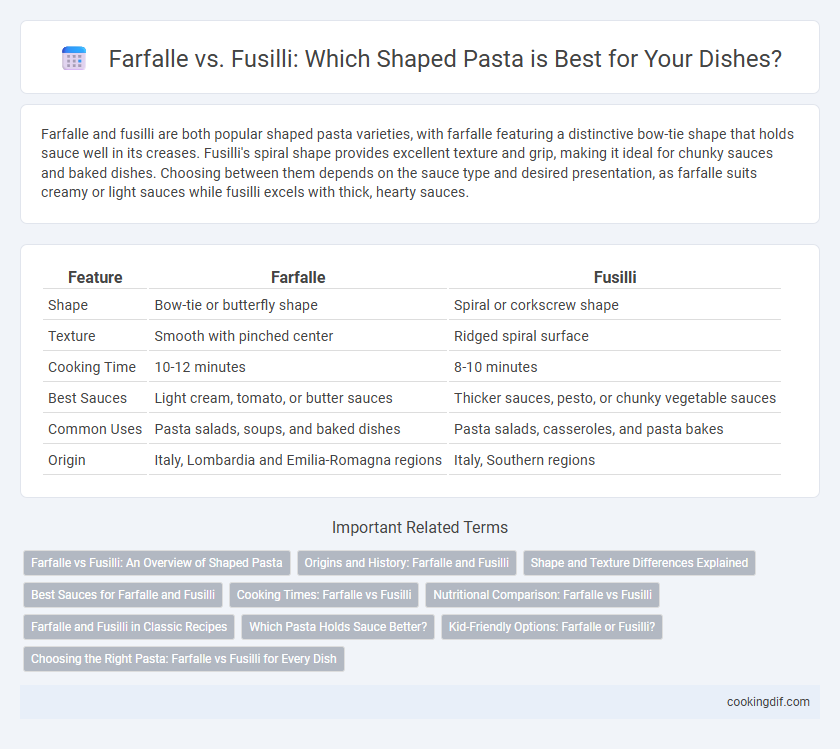Farfalle and fusilli are both popular shaped pasta varieties, with farfalle featuring a distinctive bow-tie shape that holds sauce well in its creases. Fusilli's spiral shape provides excellent texture and grip, making it ideal for chunky sauces and baked dishes. Choosing between them depends on the sauce type and desired presentation, as farfalle suits creamy or light sauces while fusilli excels with thick, hearty sauces.
Table of Comparison
| Feature | Farfalle | Fusilli |
|---|---|---|
| Shape | Bow-tie or butterfly shape | Spiral or corkscrew shape |
| Texture | Smooth with pinched center | Ridged spiral surface |
| Cooking Time | 10-12 minutes | 8-10 minutes |
| Best Sauces | Light cream, tomato, or butter sauces | Thicker sauces, pesto, or chunky vegetable sauces |
| Common Uses | Pasta salads, soups, and baked dishes | Pasta salads, casseroles, and pasta bakes |
| Origin | Italy, Lombardia and Emilia-Romagna regions | Italy, Southern regions |
Farfalle vs Fusilli: An Overview of Shaped Pasta
Farfalle and fusilli are popular shaped pasta varieties, each offering distinct textures and culinary uses. Farfalle, known as bow-tie pasta, features a flat, pinched center ideal for capturing light sauces and adding visual appeal to salads. Fusilli, characterized by its spiral form, traps thicker sauces effectively, enhancing flavor absorption in hearty dishes.
Origins and History: Farfalle and Fusilli
Farfalle, originating from the Lombardy and Emilia-Romagna regions of Northern Italy, dates back to the 16th century, its name meaning "butterflies" due to its distinctive bow-tie shape. Fusilli, on the other hand, has roots in Southern Italy, particularly Campania and Calabria, with historical evidence suggesting its use since the Roman Empire, recognized for its spiral or corkscrew form that holds sauces well. Both shapes evolved regionally, reflecting Italian culinary traditions tied to local ingredients and historical pasta-making techniques.
Shape and Texture Differences Explained
Farfalle pasta, known as "bow-tie" pasta, features a flat, pinched center with ruffled edges, creating a combination of smooth and textured surfaces that hold thicker sauces well. Fusilli pasta, characterized by its corkscrew or spiral shape, provides a uniformly ridged texture that traps lighter sauces and ingredients inside its spirals, enhancing flavor distribution. The distinct shapes of farfalle and fusilli directly influence their mouthfeel and sauce adherence, making farfalle ideal for creamy or chunky sauces and fusilli better suited for oil-based or pesto dressings.
Best Sauces for Farfalle and Fusilli
Farfalle pairs exceptionally well with creamy sauces such as Alfredo, pesto, or tomato cream due to its flat, bow-tie shape that captures thick, rich sauces in its folds. Fusilli's spiral design excels at holding onto chunky sauces like marinara, Bolognese, or vegetable ragu, allowing each bite to be flavorful and textured. Both pasta shapes are versatile but selecting sauces that latch onto their unique contours enhances the overall dining experience.
Cooking Times: Farfalle vs Fusilli
Farfalle pasta typically cooks in 10 to 12 minutes, offering a tender texture with slightly firmer edges, while fusilli cooks faster, usually within 7 to 9 minutes due to its spiral shape that allows hot water to penetrate more quickly. The ridges and curves of fusilli help sauces cling better, making it ideal for thicker or chunky sauces, whereas farfalle's shape is suited for lighter, cream-based sauces that complement its flatter surface. Choosing between farfalle and fusilli depends on the desired cooking time and the sauce type, with fusilli favored for quicker preparation and farfalle for more structured dishes.
Nutritional Comparison: Farfalle vs Fusilli
Farfalle and fusilli are both popular shaped pasta varieties with similar calorie counts, averaging around 200 calories per cooked cup. Fusilli tends to have a slightly higher fiber content due to its spiral shape, which can aid in digestion and nutrient absorption. Both types provide comparable amounts of carbohydrates and protein, making them nutritious options for balanced meals.
Farfalle and Fusilli in Classic Recipes
Farfalle, known for its distinctive bow-tie shape, is ideal in creamy sauces and classic dishes like pasta primavera or chicken Alfredo, as its flat surface holds rich, smooth textures effectively. Fusilli's corkscrew shape captures chunky sauces and ingredients well, making it a staple in traditional recipes such as pesto pasta or pasta salads with vegetables and cheese. Both pasta types excel in classic Italian cooking, but farfalle's elegant design often enhances delicate, creamy sauces, while fusilli offers superior texture for hearty, robust flavors.
Which Pasta Holds Sauce Better?
Fusilli's spiral shape creates more surface area and grooves, allowing it to hold sauces like pesto, marinara, and creamy dressings more effectively than farfalle. Farfalle's bowtie shape has a smoother surface with fewer crevices, making it better suited for lighter, less viscous sauces. For rich, chunky, or thicker sauces, fusilli provides optimal sauce retention and flavor distribution.
Kid-Friendly Options: Farfalle or Fusilli?
Farfalle and fusilli are both popular shaped pastas that appeal to kids due to their fun, playful shapes resembling bow-ties and spirals, respectively. Fusilli's corkscrew shape captures sauces and small bits of ingredients well, making it ideal for hearty or cheesy dishes that children enjoy. Farfalle's flat, wide surface offers an easier bite, which can be preferable for younger kids still developing chewing skills.
Choosing the Right Pasta: Farfalle vs Fusilli for Every Dish
Farfalle, known for its bow-tie shape, holds sauces well with its flat surfaces and pinched center, making it ideal for creamy sauces and salads. Fusilli's spiral design traps chunky sauces and ingredients, enhancing texture in baked dishes and robust tomato-based sauces. Selecting farfalle or fusilli depends on sauce consistency and recipe type, ensuring the pasta shape complements the dish's flavor and texture profile.
Farfalle vs fusilli for shaped pasta Infographic

 cookingdif.com
cookingdif.com